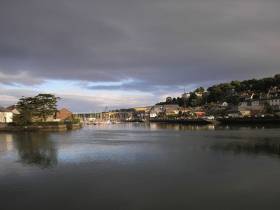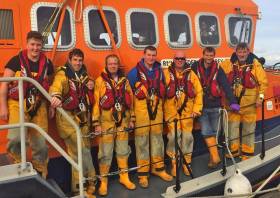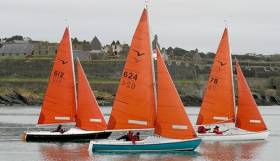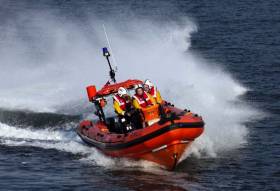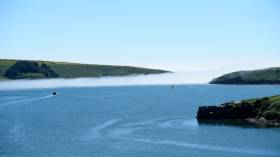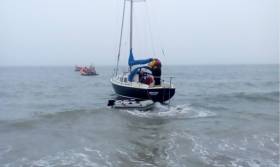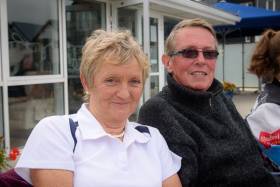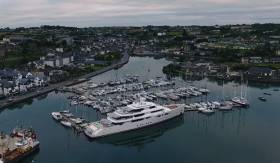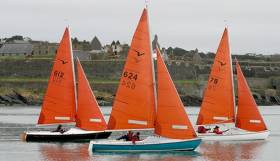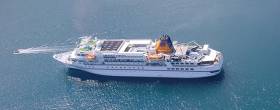Displaying items by tag: Kinsale
Kinsale Tide Times In A Tweet
#Kinsale - Harbour users in Kinsale can now check tide times online thanks to a new Twitter account.
Kindle Tides (@KinsaleTides) does exactly what the name suggests, tweeting daily with the latest tide information for the Co Cork harbour in an easy-to-use format.
#RNLI - Courtmacsherry RNLI's all-weather lifeboat was called out at 2.45pm yesterday afternoon (Sunday 2 October) as three divers and their support boat sought help as their vessel got into difficulties near Black Head off Kinsale.
The lifeboat was quickly away with a crew of seven and was on scene at 3.15pm to join Kinsale RNLI and the Irish Coast Guard boat from Oysterhaven.
As the divers and their boat were being brought back to shore, another call came from Valentia Radio of an injured crew person on board a sailing vessel off Kinsale Harbour.
Both the Kinsale and Courtmacsherry lifeboats assisted in the transfer of the female casualty to Kinsale Pier, where an ambulance was awaiting to take her to Cork University Hospital.
Conditions at sea today deteriorated from early afternoon with a Force 5 to 6 wind and a strong sea swell.
The cew on the Courtmacsherry lifeboat yesterday were coxswain Sean O'Farrell, mechanic Stewart Russell, Ciaran Hurley, Mark Gannon, Dara Gannon, Dean Hennessey and Evan O'Sullivan.
Squib Nationals Postponed Till October Over Poor Weather
#Squib - Poor weather forecast for this weekend has prompted Kinsale Yacht Club to postpone the scheduled Squib Nationals till 1-2 October.
Seven races had been planned for the Old Head of Kinsale and the Sovereign Islands in what would be the club's third time hosting the event, as previously reported on Afloat.ie.
The club has also pushed back the annual Mary P trophy race till Saturday 27 August on account of the wet and windy outlook for this weekend.
Kinsale Lifeboat Launches Twice Within Six Hours At Weekend
#RNLI - The volunteer crew from Kinsale RNLI launched twice overnight on Saturday (6 August) and into the early hours of Sunday (7 August) this past weekend.
The lifeboat first launched at 9.40pm to Saturday to aid a 26ft yacht that had become propped. Visibility was poor and weather conditions were deteriorating as the vessel was located south of the Sovereign Islands.
Lifeboat crew member Aidan Henry boarded the vessel to set up a stern tow until the lifeboat reached the Charles Fort area, when the yacht was taken alongside and returned safely to the Kinsale Yacht Club marina.
Just hours later at 3.23am on Sunday morning, the emergency pagers went off for a second time in response to reports of distress flares in the Summercove area.
Nick Searls and Jonathan Connor, who attended the earlier incident, were joined by Mark Lewis as the lifeboat searched Kinsale’s inner and outer harbours in poor visibility.
Waterford's Rescue 117 helicopter and Irish Coast Guard units from Kinsale and the Old Head of Kinsale also conducted an extensive search of the area but no vessels or persons in distress were located. The operation was called off by the coastguard at 5.15am.
"Flares are there to save lives at sea and are a vital piece of equipment for any vessel," said Kinsale RNLI lifeboat operations manager John O’Gorman. "When the RNLI receives a report of a flare being released, we respond immediately.
"We would ask every member of the public to be aware that flares should only be used in a genuine emergency as it sets in train an operation involving a large number of RNLI volunteers and resources and members of other rescue services."
Sea Fog Rolls into Kinsale Harbour
Sea fog reduced boating activity for a time today in Kinsale Harbour where sea fog rolled in from the Atlantic.
In its sea area forecast Met Eireann said a ridge of high pressure extends from the continent keeping the country in a light and humid airflow. The high will slowly drift eastwards during today and tonight. The forecaster said there would be fog locally on the east and south coast and in the Irish Sea.
#RNLI - A major search was mounted on the south coast between Crosshaven and Kinsale on Friday (15 July) after a lone yachtsman broadcast a Mayday call that he was on the rocks at the Little Sovereign Rock.
Lifeboat pagers were activated at 12.07pm and both Crosshaven and Kinsale RNLI headed to the location, joined by Crosshaven Coast Guard and the Waterford-based Irish Coast Guard helicopter Rescue 117.
Conditions were poor on scene, with a fog reducing visibility to just 200m. Kinsale RNLI found no trace of the yacht at the Sovereigns, while Crosshaven RNLI searched the shore from Roberts Head west. Crosshaven Coast Guard stood offshore as a radio relay to Valentia Coast Guard.
The Crosshaven lifeboat crew eventually located the vessel aground in Rocky Bay. One crewmember swam to the yacht with a towline and retrieved the its anchor and line. The yacht was then refloated and towed into deeper water.
After handing off the tow to Kinsale RNLI, the vessel and its yachtsman were returned to Oysterhaven none the worse for wear.
Kinsale Sailing Couple Complete Round the World Voyage
Round the World Irish sailing couple Paraic O'Maolriada and Myra Reid returned to their home port of Kinsale in County Cork at the weekend having completed a six–year circumnavigation writes Bob Bateman.
The fluent Irish speakers returned to the West Cork port on Saturday in their 63–foot long yacht 'Saol Eile' to be greeted by family and friends. The craft was dressed with flags from all the countries they had visited over the course of their 43,000 nautical miles voyage.
Paraic, a non–swimmer, was formerly a master brewer in Guinness Brewery who has also designed breweries in Scotland. Paraic says it was a relatively quick decision to 'pack it all in' and take on the global journey.
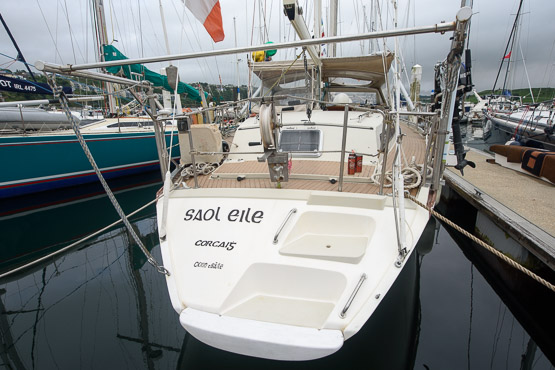 Above and below: The 63–footer yacht Saol eile safely back in Kinsale after its round–the–world voyage. Photos: Bob Bateman
Above and below: The 63–footer yacht Saol eile safely back in Kinsale after its round–the–world voyage. Photos: Bob Bateman
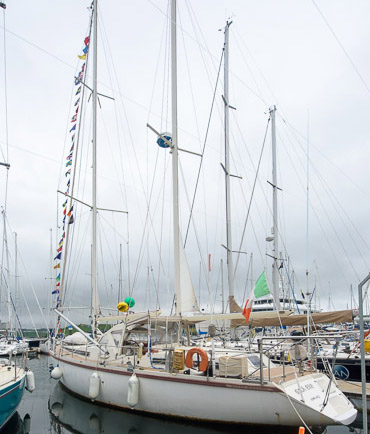
The couple prepared for the journey in 2010 with assistance from Zafer Guray of Bantry who gave them tips about how to handle the boat with just the two of them onboard.
Married for 49–years, Paraic and Myra said their scariest moment of all came on day two when the short–handed couple encountered a force nine storm in the Bay of Biscay.
Their most pleasant cruising experience was in Namibia, sighting hundreds of thousands of birds pelicans and flamingos. Another place they loved was Madagascar with its multitude of beautiful anchorages. But Myra says overall that 'the best part of the trip was being home'.
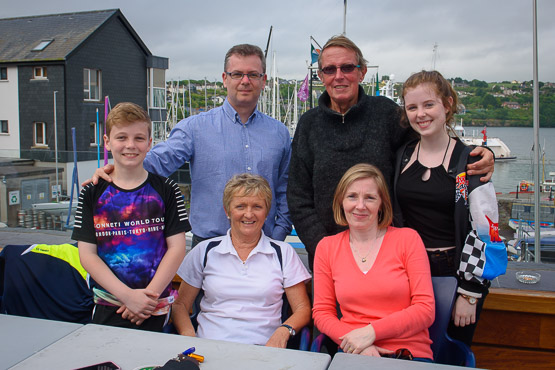 Round the World Irish sailing couple Paraic O'Maolriada and Myra Reid reunited with family at Kinsale Yacht Club. Photo: Bob Bateman
Round the World Irish sailing couple Paraic O'Maolriada and Myra Reid reunited with family at Kinsale Yacht Club. Photo: Bob Bateman
Kinsale Marina & Super Yacht Video From The Air
With aerial views of the Charles Fort, James Fort, visiting Super yacht 'Grace E' and the town marina, Kinsale is filmed by drone pilot Daniel Foran with spectacula results for the harbour that marks the start of the Wild Atlantic Way.
Kinsale Yacht Club host the Irish Squib National Championships for the third time in August. They hosted it first on 2008 and again in 2013 when KYC members James and Bruce Mathews in Mucky Duck took the title.
Seven races are planned between the Old Head of Kinsale and the Sovereign Islands in the Bandon Co–Op Sponsored event. Last year, the Irish title went to UK visitors, father and son crew Nigel and Jack Grogan of the Royal Corinthian Yacht Club at Burnham–on–Crouch, when the event was sailed at Howth Yacht Club.
Bere Island & Kinsale Welcome Cruise Ships
Spanish Armada, French Armada, English forces, Vikings, the Lusitania. West Cork towns have had their share of maritime history over the years but this coming week will see history in the making when new visitors, this time invited ones, will arrive by sea to experience some of County Cork’s gems.
This Thursday, June 9th, the German cruise ship, the Bremen, will anchor just off Bere Island and 100 German passengers plus crew will zip ashore on some of the ship’s 12 onboard Zodiacs. With Hungry Hill as its backdrop and the historical island its destination, passengers will land at Lawrence Cove Marina, where they will be whisked to the Heritage Centre to learn about the island, its history and culture. From there, they have the option of hiring bikes, joining a guided walking tour or participating in some unique experiences – pulling a pint in the village pub or footing turf, for example.
“The community of Bere Island has gone out of its way to customise experiences for these guests and we are confident that the welcome they have planned for them will result in exceptional feedback from the passengers and crew and future calls of even longer duration in coming years.
“We are excited by the opportunity we believe the West Cork Islands present for expedition operators such as Hapag Lloyd Cruises and are in no doubt about the economic benefit that direct calls such as these can deliver to the community. ” says Clodagh Henehan, Divisional Manager, West Cork for Cork County Council.
Later, on June 13th and again on the 20th. National Geographic Orion, with mainly American guests onboard, will call to Kinsale. Anchoring in sight of the spectacular, clifftop, Charles Fort, the Orion’s guests will enjoy historical walking tours of Kinsale Town and take in the Old Head of Kinsale on the Wild Atlantic Way.
This is the first season that the Orion has been deployed in Europe – it is more usually to be found in the Arctic and Antarctic regions. Combining adventure with luxury for its discerning and highly experienced travelers, this expedition ship also seeks out smaller harbours on its itineraries.
“Guests on these smaller cruise ships are seeking destinations where larger ships and mass tourism has not reached. It’s all about authentic experiences and West Cork, with all it offers, is ideal for them”, comments Clodagh Henehan. “Additionally, in recent research, 67% of cruise passengers said they returned to a destination after visiting it on a cruise. So, for us and for tourism development in the region, it’s a no-brainer.”
At the end of 2013, as part of its economic development remit for the region, Cork County Council identified the need to actively intervene to arrest the decline in cruise ship calls into Glengarriff, for which they were then responsible. They put in place a two-pronged promotional campaign that sought
to attract additional cruise ships into West Cork and to increase the shore excursions for cruise passengers in West Cork.
With decisions about deployment taking place some 3 years down the line, this is the first year that the efforts on the itinerary planning side are now paying off and the opportunity of attracting smaller ships into lesser known harbours has been realised. A further new cruise ship company is scheduled to call to Kinsale in 2017.
Additionally, Glengarriff which is serviced now by the Port of Cork, will have 7 ship calls in 2017, many of them new clients and all of them larger ships with an average of 600 passengers each. Significantly, one of these companies, Holland America Line, is one of the first American companies to call to Glengarriff which has traditionally appealed to a more European and UK market and it is hoped this will attract further US cruise operators to West Cork.


























